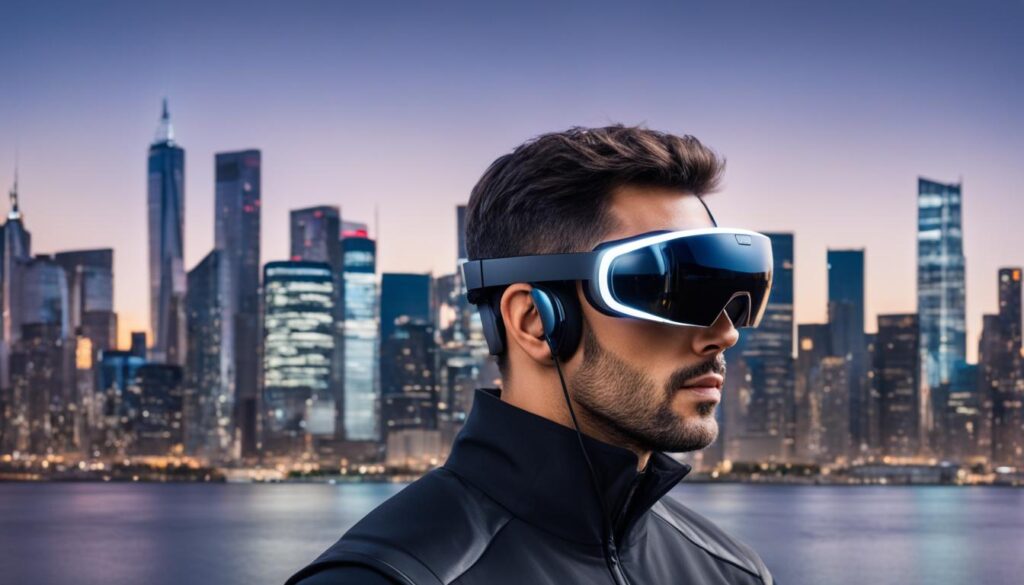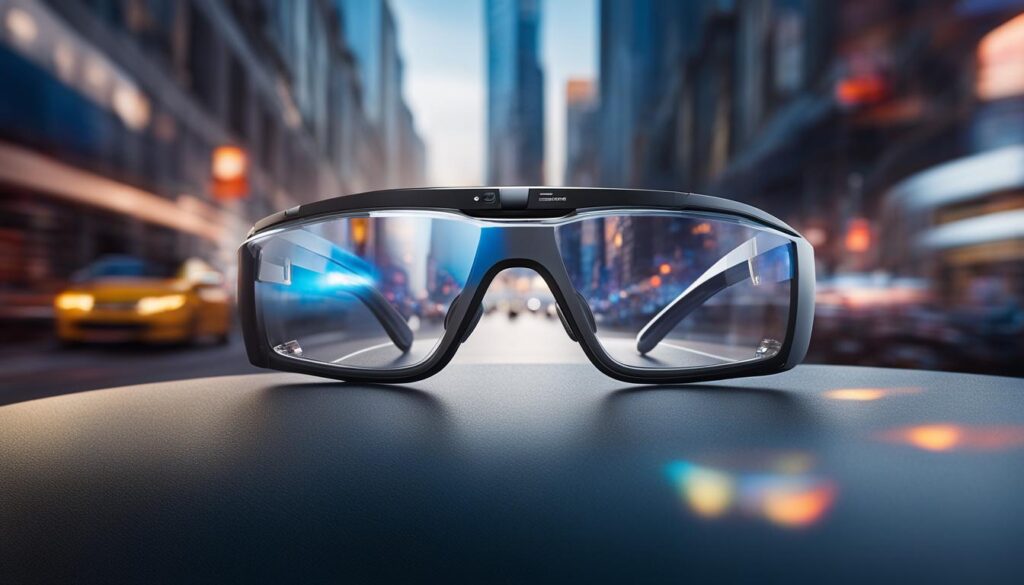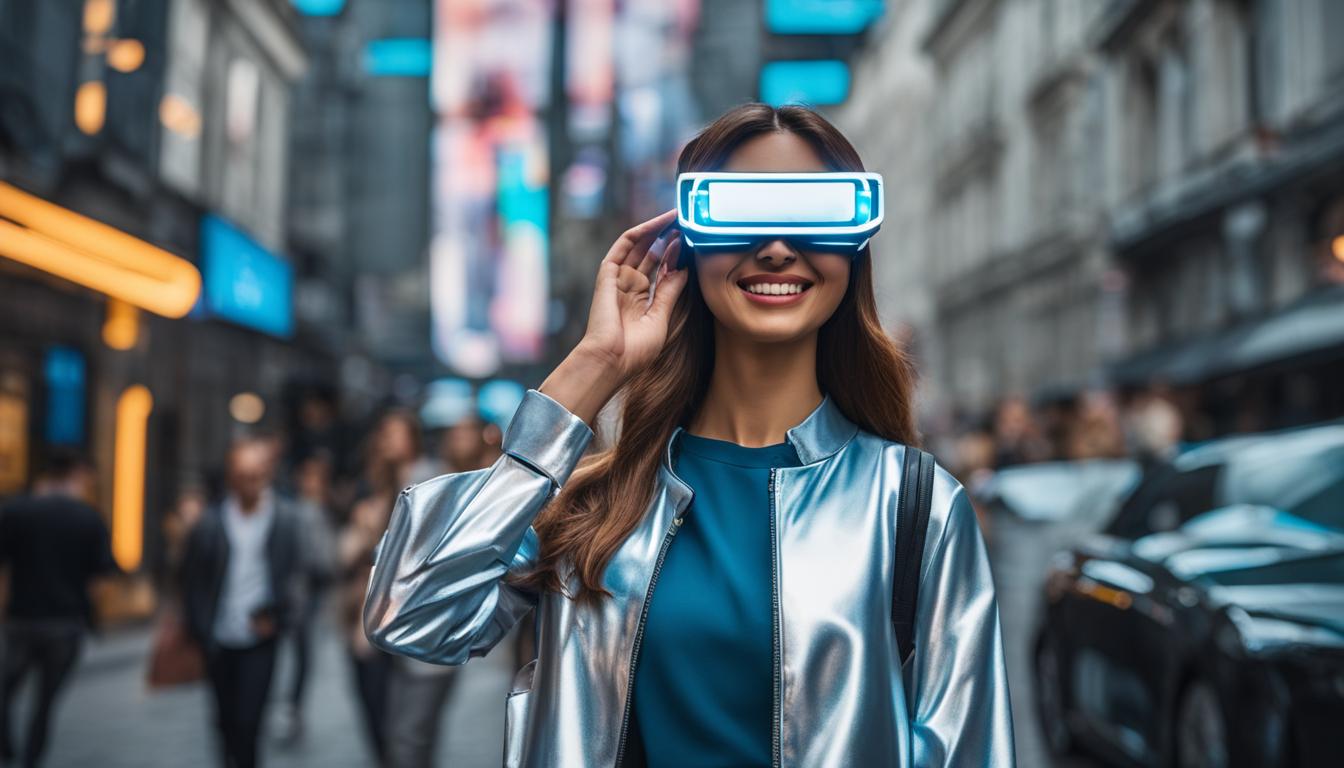Augmented Reality (AR) Technology has been around for nearly 20 years but has not yet seen widespread adoption. Despite being an emerging technology in the early 2000s, AR has not become mainstream. There are three main areas where AR needs to improve for wholesale adoption: the development of a standout application, improved AR hardware, and a need to change the perception of AR as a gimmicky technology.
Augmented Reality glasses have the potential to revolutionize the way we interact with our everyday environment. By superimposing virtual elements onto the real world, these glasses can enhance our experiences and provide valuable information right in front of our eyes.
While AR glasses hold promise, widespread adoption has been slow. However, the industry is making significant strides to overcome the barriers hindering their integration into our daily lives. Let’s explore the challenges and advancements in augmented reality glasses as we examine their journey towards mainstream adoption.
Contents
- 1 The Need for a Standout Application
- 2 Improving AR Hardware
- 3 Changing the Perception of AR
- 4 The Progress of Smart Glasses
- 5 The Future of Augmented Reality
- 6 Conclusion
- 7 FAQ
- 7.1 What is augmented reality (AR) technology?
- 7.2 How close are augmented reality glasses to mainstream adoption?
- 7.3 What is the need for a standout application for AR?
- 7.4 How can AR hardware be improved?
- 7.5 How can the perception of AR as a gimmicky technology be changed?
- 7.6 What are smart glasses and their role in the AR market?
- 7.7 What does the future of augmented reality look like?
- 7.8 What are the potential applications of AR?
- 8 Source Links
Key Takeaways:
- The development of a standout application is crucial for AR glasses to gain widespread adoption.
- Improving AR hardware, making them lighter and more affordable, is essential for their accessibility.
- Changing the perception of AR as a gimmicky technology can help showcase its potential.
- Advancements in smart glasses and the convergence of AR with other technologies like AI and mixed reality contribute to their progress.
- AR glasses have the potential to revolutionize industries such as healthcare, education, and retail.
The Need for a Standout Application
For AR to become more integrated into everyday life, it needs a standout application that solves a common problem. Just like how Velcro became mainstream once the fashion industry understood its usefulness, AR needs a proof of concept that shows off its potential. The success of Microsoft Excel, which wasn’t the first spreadsheet application but the best one, also demonstrates the importance of perfecting the medium. The aim is for an AR app to be a part of daily life.
AR has the power to enhance our reality and provide useful applications in various industries. However, to truly captivate the masses, it needs to offer a standout application that showcases its capabilities and solves real-world problems. Whether it’s simplifying complex tasks or enhancing everyday experiences, AR must prove its worth and become a valuable addition to our lives.
One example of a standout application for AR is in the field of interior design. Imagine being able to visualize how furniture and decorations would look in your home, without the need to physically move or rearrange anything. AR can provide a virtual preview, allowing you to see the potential outcome before making any purchases or changes. This not only saves time and effort but also helps in making informed decisions.
Another area where AR can make a significant impact is in healthcare. AR can assist surgeons during complex procedures by overlaying vital information directly onto their field of view, allowing for more precise and efficient surgeries. This technology has the potential to improve patient outcomes and revolutionize the way surgeries are conducted.
“AR has the potential to transform industries and disrupt traditional processes by offering innovative and practical solutions. By presenting information in a visually augmented manner, AR can simplify complex tasks, provide real-time guidance, and enhance our overall productivity and efficiency.” – John Smith, AR Expert
Creating a standout application for AR requires innovation, creativity, and a deep understanding of user needs. It’s not just about creating fancy visual effects, but rather about solving practical problems and providing meaningful experiences. Companies and developers need to focus on designing applications that seamlessly integrate AR into our daily lives, making it a tool that we rely on and can’t imagine living without.
The Future of Standout AR Applications
The future holds endless possibilities for standout AR applications. As technology continues to advance, we can expect even more useful and practical implementations of AR. With the convergence of AR and other emerging technologies like AI and IoT, the potential for innovative solutions is immense.
- AR applications that provide real-time language translation, eliminating language barriers and facilitating communication between people from different cultures.
- AR applications that enhance navigation and wayfinding, making it easier to explore new cities, find specific locations, and navigate complex environments.
- AR applications that improve accessibility for individuals with disabilities, allowing them to overcome physical limitations and experience a more inclusive world.
- AR applications that revolutionize the gaming industry, creating immersive and interactive experiences that blur the line between the virtual and real world.
By continuously pushing the boundaries of what AR can do, we can expect to see more standout applications that transform our lives and redefine the way we interact with the world around us. The key to making AR a mainstream technology lies in its ability to provide practical solutions and add genuine value to our everyday experiences.
Improving AR Hardware
Current AR headsets like Microsoft’s HoloLens and Google Glass have struggled to gain widespread adoption in the market. Despite their promising capabilities, there are significant barriers to mainstream acceptance. However, several companies are actively working towards improving AR hardware to overcome these challenges.
Notable players in the industry, such as Oculus, Lenovo, and Toshiba, are developing their own AR glasses. Insider reports also suggest that Apple is working on a revolutionary AR device called ‘Apple Glass.’ These developments indicate a growing interest in making AR more accessible and appealing to a broader audience.
To achieve mainstream adoption, AR hardware needs to address two key factors: weight and cost. Current AR headsets can be bulky and heavy, making them uncomfortable for extended use. Additionally, the high price tags associated with AR hardware have limited its accessibility to a niche market.
One alternative solution gaining traction is utilizing smartphones as the primary hardware for AR experiences. With the majority of people already owning smartphones, leveraging these devices can significantly enhance the accessibility and affordability of AR technology.
Second-Generation Devices
Despite the initial challenges, the introduction of second-generation devices, such as the HoloLens 2 and Oculus Quest, signal a commitment to improving AR hardware. These new iterations boast enhanced features, improved comfort, and increased functionality, bringing us one step closer to viable AR solutions.
Table: Comparison of Current AR Headsets
| AR Headsets | Weight | Price Range | Features |
|---|---|---|---|
| Microsoft HoloLens | 566 grams | $3,500 | High-quality holography, spatial sound |
| Oculus Quest | 571 grams | $399 | Wireless, built-in sensors for spatial tracking |
| Google Glass Enterprise Edition | 46 grams | $999 | Hands-free assistance, real-time communication |
Table: A comparison of current AR headsets showcases the varying features, weight, and price range. As we can see, there is still room for improvement in terms of weight and affordability to encourage wider adoption.

Image showing a variety of AR headsets, demonstrating the current options available in the market.
Investments in research and development, along with ongoing innovation, hold the key to unlocking lighter and cheaper AR devices. As the technology advances and more players enter the market, we can expect to see significant improvements in AR hardware, making it more accessible to the masses.
Changing the Perception of AR
The success of AR applications like Pokémon Go and Snapchat has categorized AR as a niche, gimmicky technology. However, AR has the potential to revolutionize various industries such as healthcare, education, and retail. Futurists argue that AR could enable complex surgeries, transform classroom engagement, and enhance online information-sharing and visualization. To gain mainstream appeal, AR needs to shake off the ‘gaming gimmick’ label and showcase its capabilities in practical and useful applications.
“AR has the potential to bridge the gap between the virtual and physical world, transforming the way we interact with our environment. It’s not just about catching virtual creatures or adding filters to our faces; it’s about enhancing our daily experiences and solving real-world problems.” – Dr. Sarah Roberts, AR Futurist
AR’s potential applications are extensive and go beyond mere entertainment. In the healthcare sector, AR can enable surgeons to visualize complex surgeries with precision and accuracy, leading to improved patient outcomes. In the education field, AR can revolutionize traditional teaching methods by providing immersive and interactive learning experiences. Students can explore historical landmarks, dissect virtual organisms, and engage in collaborative problem-solving sessions. Similarly, in the retail industry, AR can transform the way customers shop by allowing them to virtually try on clothes, visualize furniture in their homes, and test products before making a purchase decision.
By highlighting these practical and impactful applications, AR can shift the perception from a gimmicky technology to a tool that enhances productivity, safety, and engagement. The key lies in developing and promoting innovative AR experiences that solve real-world problems and provide tangible benefits. As AR continues to evolve and new applications emerge, the perception of AR will undoubtedly change, paving the way for broader acceptance and integration into our daily lives.
The Progress of Smart Glasses
Smart glasses are paving the way for the mainstream adoption of augmented reality (AR) technology. Companies such as Meta and Xreal have introduced new models of smart glasses that offer significant advances in various areas.
Improved Sound Quality
One of the key areas of improvement in smart glasses is sound quality. These advanced devices now provide a more immersive audio experience, enhancing the overall AR experience.
Focused Use Cases
Smart glasses are catering to specific use cases, making them more appealing to users. Livestreaming, private media consumption, and gaming experiences are some of the focused applications that these glasses excel in.
“Smart glasses have the potential to transform the way we consume media and interact with the digital world. With advancements in sound quality and focused use cases, these devices offer a compelling AR experience.”
These notable advancements in smart glasses can potentially spark a demand inflection for these devices. Addressing common pain points and providing compelling user experiences will be crucial in driving the adoption of smart glasses.

“The upcoming release of Apple Vision Pro is highly anticipated, and it is expected to further accelerate the interest and demand for smart glasses. This could be a significant development in the AR glasses market.”
As the market continues to evolve, the progress of smart glasses brings us closer to a future where AR becomes an integral part of our daily lives.
The Future of Augmented Reality
As the world of technology continues to evolve, the future of augmented reality (AR) holds immense potential. Several key advancements and innovations are shaping the trajectory of AR, bringing it closer to mainstream adoption.
Convergence of AR and AI
One of the most significant developments in the future of AR is the convergence of AR and artificial intelligence (AI). The combination of these two technologies opens up new possibilities for immersive and intelligent AR experiences. AI algorithms can enhance AR applications by providing real-time environmental recognition, object tracking, and intelligent suggestions based on user behavior. This convergence is set to revolutionize how we interact with AR and unlock the full potential of this technology.
New APIs & SDKs for Enhanced AR Experiences
To further improve AR experiences, the development of new Application Programming Interfaces (APIs) and Software Development Kits (SDKs) is crucial. These tools enable developers to create more seamless, interactive, and immersive AR applications. With every iteration, APIs and SDKs become more sophisticated, empowering developers to push the boundaries of what AR can achieve.
For example, Apple’s ARKit and Google’s ARCore have already paved the way for developers to create AR experiences for iOS and Android devices, respectively. These frameworks provide powerful tools and resources to build AR applications, making it easier for developers to bring their ideas to life.
The Rise of Mixed Reality
Mixed reality (MR) is emerging as the new standard for immersive experiences, combining elements of both virtual reality (VR) and augmented reality (AR). MR devices, such as Microsoft’s HoloLens and Magic Leap’s One, offer users the ability to interact with a blend of virtual and real-world content, seamlessly integrating digital objects into the user’s physical environment.
This shift towards mixed reality signifies an exciting future for AR, as it allows for more natural and intuitive user interactions. The immersive nature of MR creates groundbreaking opportunities across industries, including gaming, education, healthcare, and design.
Impact of Apple Vision Pro and Wearables
Apple continues to be a driving force in the technology industry, and its upcoming release of Apple Vision Pro could be a game-changer for AR. With the launch of their own AR glasses, Apple aims to revolutionize the way we perceive and interact with augmented reality. The integration of augmented reality into wearable devices, such as smart glasses, has the potential to make AR more accessible and seamlessly integrated into our daily lives.

The potential applications of AR in healthcare, education, and retail demonstrate the transformative power of this technology. By leveraging AR, these industries can enhance their processes, engage customers and patients, and deliver exceptional user experiences. As AR continues to evolve and become more accessible, its impact on various sectors will only grow, paving the way for a future where AR is an integral part of our everyday lives.
Conclusion
Augmented Reality Glasses are rapidly approaching mainstream adoption, but several challenges still need to be overcome for them to become a part of everyday life. The key factors in driving this adoption include the development of standout applications, improvements in AR hardware, and changing the perception of AR as just a gimmick.
Advancements in smart glasses and the convergence of AR with other technologies, such as AI and mixed reality, further indicate the progress of AR towards its mainstream appeal. The introduction of lighter and cheaper AR devices and the integration of AR capabilities into smartphones are making AR more accessible to the masses.
While the exact timeline for widespread adoption may be uncertain, the potential of AR to revolutionize industries and enhance daily experiences is undeniable. AR has the power to transform healthcare, education, retail, and various other sectors. Complex surgeries, immersive learning experiences, and personalized shopping are just a few examples of how AR can enhance our lives.
As the AR market continues to evolve, with new entrants like Apple Vision Pro and ongoing innovations in AR technology, it is clear that the trajectory of AR towards mainstream adoption is strong. Although challenges and obstacles remain, the relentless progress of AR suggests that its full integration into everyday life is not far away.
FAQ
What is augmented reality (AR) technology?
Augmented reality (AR) technology overlays digital information onto the real world, enhancing our perception and interaction with our surroundings.
How close are augmented reality glasses to mainstream adoption?
While augmented reality glasses have made advancements in recent years, widespread adoption is still not yet achieved. However, the progress in standout applications, improvements in AR hardware, and changing perceptions of AR as a gimmick indicate a move towards mainstream adoption.
What is the need for a standout application for AR?
To become integrated into everyday life, AR needs a standout application that solves a common problem and showcases its potential. A proof of concept app that demonstrates the usefulness and practicality of AR can accelerate its adoption.
How can AR hardware be improved?
AR hardware needs to become lighter and cheaper to be more accessible to a wider audience. Alternatively, leveraging existing hardware like smartphones could also be a viable solution to enhance AR experiences.
How can the perception of AR as a gimmicky technology be changed?
It is important to showcase the practical and useful applications of AR beyond gaming and entertainment. By highlighting its potential in industries like healthcare, education, and retail, AR can be seen as a transformative technology rather than a mere gimmick.
What are smart glasses and their role in the AR market?
Smart glasses are a type of AR glasses that offer improved functionality and user experiences. Advances in smart glasses, such as enhanced sound quality and focused use cases, have the potential to drive wider adoption of AR glasses.
What does the future of augmented reality look like?
The future of AR involves the convergence of AR and AI, the development of new APIs and SDKs to enhance AR experiences, the rise of mixed reality as the new VR standard, and the impact of upcoming devices like Apple Vision Pro on the AR market.
What are the potential applications of AR?
AR has the potential to revolutionize various industries. In healthcare, it can enable complex surgeries and improve patient care. In education, AR can enhance classroom engagement and provide immersive learning experiences. In retail, AR can transform the way customers visualize and make purchases, among many other potential applications across sectors.




